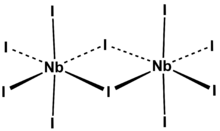Chemistry:Niobium pentaiodide

| |
| Names | |
|---|---|
| Other names
Niobium(V) iodide
| |
| Identifiers | |
3D model (JSmol)
|
|
| ChemSpider | |
| EC Number |
|
PubChem CID
|
|
| UNII | |
CompTox Dashboard (EPA)
|
|
| |
| |
| Properties | |
| Nb2I10 | |
| Molar mass | 1475 |
| Appearance | yellow solid |
| Density | 5.30 g/cm3 |
| Melting point | 543 °C (1,009 °F; 816 K) sublimes |
| Hazards | |
| GHS pictograms | 
|
| GHS Signal word | Danger |
| H314 | |
| P260, P264, P280, P301+330+331, P303+361+353, P304+340, P305+351+338, P310, P321, P363, P405, P501 | |
Except where otherwise noted, data are given for materials in their standard state (at 25 °C [77 °F], 100 kPa). | |
| Infobox references | |
Niobium pentaiodide is the inorganic compound with the formula Nb2I10. Its name comes from the compound's empirical formula, NbI5.[1] It is a diamagnetic, yellow solid that hydrolyses readily. The compound adopts an edge-shared bioctahedral structure, which means that two NbI5 units are joined by a pair of iodide bridges. There is no bond between the Nb centres.[2] Niobium(V) chloride, niobium(V) bromide, tantalum(V) chloride, tantalum(V) bromide, and tantalum(V) iodide, all share this structural motif.
Preparation
Niobium pentaiodide forms from the reaction of niobium with iodine:
- 2 Nb + 5 I2 → 2 NbI5
The method used for the preparation of tantalum(V) iodide using aluminium triiodide fails to produce pure pentaiodide.[3]
Properties
Niobium(V) iodide forms of dark, brassy, extremely moisture-sensitive needles or flakes. Its crystallises in the monoclinic crystal system with space group P21/c (space group no. 14), a = 1058 pm, b = 658 pm, c = 1388 pm, β = 109.14°. The crystal structure consists of zigzag chains of corner-sharing NbI6 octahedra. Since so far only twinned crystals of this phase have been obtained, and the structure determination is uncertain.[4] If the reaction of the elements is carried out with an excess of iodine, a triclinic modification is created with the space group P1 (No. 2), a = 759.1 pm, b = 1032.2 pm, c = 697.7 pm, α = 90 .93°, β = 116.17°, γ = 109.07°, which consists of isolated molecules Nb2I10.[3][5] This structure is isotypic with that of triclinic niobium(V) bromide.
References
- ↑ Greenwood, N. N.; & Earnshaw, A. (1997). Chemistry of the Elements (2nd Edn.), Oxford: Butterworth-Heinemann. ISBN:0-7506-3365-4.
- ↑ Krebs, Bernt; Sinram, Diethard "Darstellung, Struktur und Eigenschaften einer neuen Modifikation von NbI5 (Preparation, structure and properties of a new modification of NbI5" Zeitschrift fǔr Naturforschung, Teil B: Anorganische Chemie, Organische Chemie 1980, volume 35b, pp. 12-16.
- ↑ 3.0 3.1 G. Braurer (1963). "Niobium(V) Iodide". in G. Brauer. Handbook of Preparative Inorganic Chemistry, 2nd Ed.. 1. NY, NY: Academic Press. pp. 1315.
- ↑ Littke, W.; Brauer, G. (Oct 1963). "Darstellung und Kristallstruktur von Niobpentajodid" (in en). Zeitschrift für anorganische und allgemeine Chemie 325 (3-4): 122–129. doi:10.1002/zaac.19633250304. ISSN 0044-2313. https://onlinelibrary.wiley.com/doi/10.1002/zaac.19633250304.
- ↑ B. Krebs, D. Sinram: Darstellung, Struktur und Eigenschaften einer neuen Modifikation von NbI5. In: Zeitschrift fuer Naturforschung, Teil B. Anorganische Chemie, Organische Chemie, 1980, 35, S. 12–16.
| HI | He | ||||||||||||||||
| LiI | BeI2 | BI3 | CI4 | NI3 | I2O4, I2O5, I4O9 |
IF, IF3, IF5, IF7 |
Ne | ||||||||||
| NaI | MgI2 | AlI3 | SiI4 | PI3, P2I4 |
S | ICl, ICl3 |
Ar | ||||||||||
| KI | CaI2 | Sc | TiI4 | VI3 | CrI3 | MnI2 | FeI2 | CoI2 | NiI2 | CuI | ZnI2 | Ga2I6 | GeI2, GeI4 |
AsI3 | Se | IBr | Kr |
| RbI | SrI2 | YI3 | ZrI4 | NbI5 | Mo | Tc | Ru | Rh | Pd | AgI | CdI2 | InI3 | SnI4, SnI2 |
SbI3 | TeI4 | I | Xe |
| CsI | BaI2 | HfI4 | TaI5 | W | Re | Os | Ir | Pt | AuI | Hg2I2, HgI2 |
TlI | PbI2 | BiI3 | Po | AtI | Rn | |
| Fr | RaI2 | Rf | Db | Sg | Bh | Hs | Mt | Ds | Rg | Cn | Nh | Fl | Mc | Lv | Ts | Og | |
| ↓ | |||||||||||||||||
| La | Ce | Pr | Nd | Pm | SmI2 | Eu | Gd | TbI3 | Dy | Ho | Er | Tm | Yb | Lu | |||
| Ac | ThI4 | Pa | UI3, UI4 |
Np | Pu | Am | Cm | Bk | Cf | EsI3 | Fm | Md | No | Lr | |||
 |

